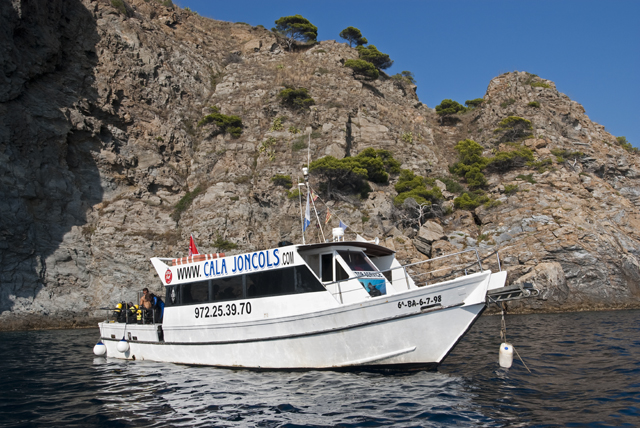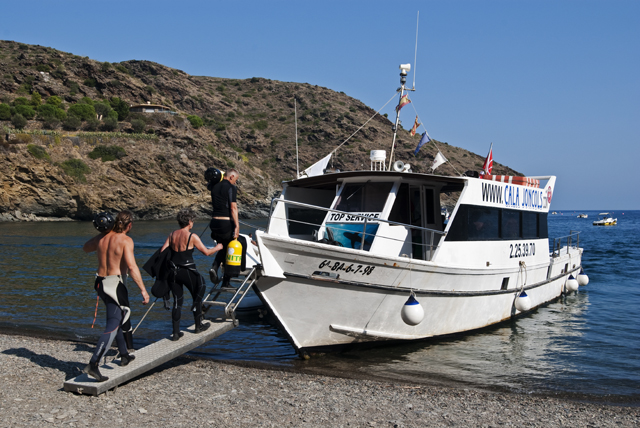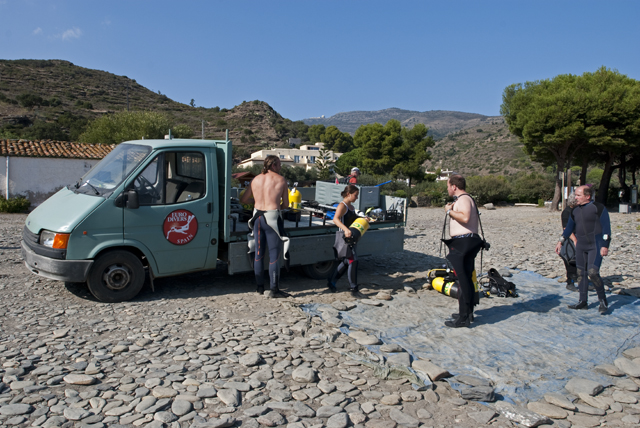News
Diving in Cala Joncols, Spain

When Jan Boelen, the owner of Euro-Divers, said that Cala Joncols Hotel in Spain reminded him of Fawlty Towers I thought “oh s***, what have I let myself in for?” I had visions of complete mayhem and disaster with Basil goose-stepping around the corridors all night long. My concerns were further raised when Belgian born Jan told me that the owner was called Manuel and he actually came from Barcelona! This definitely had the makings of an eventful week.
I had booked a flight with budget airline Ryanair flying locally from Bournemouth to Girona. The transfer to Cala Joncols would take about an hour so this gave me plenty of time to quiz Jan on what other surprises lay in store. I also noticed that Jan had some disturbingly similar ‘Basil’ traits. Maybe spending the past 9 seasons at the secluded little bay had taken its toll?
 Jan began diving in 1991 and has had plenty of worldly experience including stints in the Caribbean, Thailand and the Maldives. He runs the Spanish operation along with his wife, Martine (she looks nothing like Sybil). The day to day tasks are handled by Assistant Manager Etienne Zind. Even though Jan had been offered more prestigious dive centres under the Euro-Divers banner he was content to stay at Cala Joncols. Jan had even bought an apartment in the nearby town of Roses so there were no plans to move away just yet.
Jan began diving in 1991 and has had plenty of worldly experience including stints in the Caribbean, Thailand and the Maldives. He runs the Spanish operation along with his wife, Martine (she looks nothing like Sybil). The day to day tasks are handled by Assistant Manager Etienne Zind. Even though Jan had been offered more prestigious dive centres under the Euro-Divers banner he was content to stay at Cala Joncols. Jan had even bought an apartment in the nearby town of Roses so there were no plans to move away just yet.
I arrived at the Cala Joncols Hotel early evening and to my relief the place was nothing like Fawlty Towers. The building was surrounded by olive trees, shrubs, flowers and overhanging plants. From my Balcony I could see the swimming pool, pebble beach and then the sea approx 30 – 40 metres away. The Bay itself is flanked on either side by steep sided cliffs. There are no other Hotels, Restaurants or Bars in the bay so don’t expect any thriving night life. The patio area was alive with people enjoying the Friday Evening Barbecue. Clientele was mainly German, French and Spanish with a few Brits dotted about here and there.
Manuel Gomez Fernandez has worked at the Hotel since 1968 and became the owner back in 2000. It’s a family owned and family run business. There are 35 rooms and 4 Bungalows (4 people per Bungalow) for rent. The white washed rooms are maintained to a good standard. Some have ultra modern bathrooms and sea view balconies. Downstairs there’s a bar with internet access. This is a full on divers resort so a good number of the rooms have been allocated for Euro-Divers clientele. Jan’s wife Martine deals with all the dive centre bookings. She also doubles up as a dive guide when time permits. The rest of the rooms are filled up by guests enjoying other outdoor pursuits like kayaking, walking and mountain biking. During my stay the Hotel was full of Thai Chi enthusiasts and a group of Naturists. The crescent shaped Beach is big enough for everybody although I did get an eyeful of bare flesh from time to time.
In the summer months the protected bay is also a popular spot for visiting Yachts and power boats. The Restaurant is top rated. Food is typically Spanish so don’t expect Beans and Burgers. Full board diving guests are served up a set 3/4 course menu every evening around 7-30pm. There’s only one choice available but the kitchen will rustle up an alternative if someone has a specific dislike. Fresh fish in some form or other is normally on offer.
The whole diving set up runs extremely well and in fact it reminded me of a kind of ‘land based’ Liveaboard operation. I didn’t have to venture too far for anything. A normal diving day consists of 2 boat dives. The first is at 10am and the second at 4pm. Jan said that they do double boat runs (4 dives a day) in high season. There’s also unlimited shore diving and night dives available.
I arrived at the end of October. The main season is between April and November but this peaks in July and August. Jan said the best time to visit is around September. The weather is still warm and the evenings are slightly cooler. I sat down and filled in the mandatory liability and release paperwork and was pleasantly surprised when Jan said “We don’t ask you to do a check dive. You have a qualification and a logbook. We treat everybody as a diver. We do a good briefing and then you do your dive. Divers don’t have to be guided”.
The core Staff is made up of 3 full time Instructor/Dive Guides (everybody spoke good English). Etienne went over the logistics for a normal diving day which in my case started with an early morning swim followed by a leisurely Breakfast. At around 9-30am I grabbed all my kit from the drying/equipment room, put my suit on and walk down to the beach carrying everything except a cylinder. The cylinders are filled every night and then brought down to the beach in a van. 32% Nitrox is free and most of the cylinders are 12 Litre steel dumpy’s with twin valves (apparently this is a European requirement). Jan said “in 9 seasons we have had no major incidents. Nitrox for free helps”. Jan explained that for added safety 85% of the divers used Nitrox on an air profile while keeping a close eye on depth limitations. When I had finished setting up my equipment I just had to walk to the water’s edge where the boat was waiting for us.
Euro Divers have one hard boat capable of carrying up to 36 divers. This is owned by the Hotel and skippered by one of Manuel’s sons, Michael. They offer 18 different dive sites inside the Cap de Creus natural park. Maximum on-water travel time to the furthest site is 20 minutes each way. The boat returns around 12-30pm ready for lunch at 1-00pm. This gave me a few hours of Siesta R and R before going through the same routine all over again at 3-30pm.
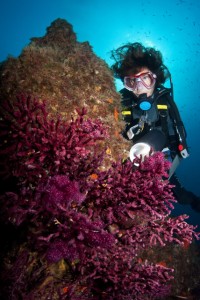
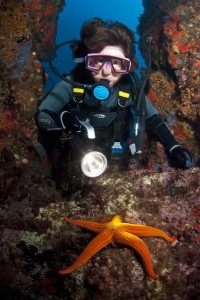 Martine and Etienne took in turns to guide me around the dive sites. I split my dives between macro and wide angle so I could get a good overall feel for the place. Water temp rises to a maximum of 24 degrees in July and then starts to cool down in September. I was wearing a full 6mm suit without a hood and felt pretty comfortable. Martine was wearing a hood so I made her take this off for my photos as and when necessary. Jan said “the diving here is very good for the Med”. Cape Norfeu was Jan’s favourite dive site so I was looking forward to experiencing it first-hand. I followed Martine down the mooring line and then across the bottom to a wall packed full of purple coloured Gorgonians. The sun was in the right position for photos and the visibility topped 20 metres. I dropped down to 30m and was still nowhere near the bottom. Jan had said that dives are limited to a maximum of 40m but I’m sure there were a few sneaky members of the French contingent going way beyond this depth. We finned along the wall and then headed across the rock/boulder strewn bottom towards a shallow cave/air pocket. There were plenty of big Groupers on show but they just wouldn’t let me get close enough for a picture. All in all it was a great dive. Jan had said “if you come here for big fish you will be disappointed”, but there was still plenty to see including free swimming Morays, Banded Bream and shoals of yellow striped Saupe.
Martine and Etienne took in turns to guide me around the dive sites. I split my dives between macro and wide angle so I could get a good overall feel for the place. Water temp rises to a maximum of 24 degrees in July and then starts to cool down in September. I was wearing a full 6mm suit without a hood and felt pretty comfortable. Martine was wearing a hood so I made her take this off for my photos as and when necessary. Jan said “the diving here is very good for the Med”. Cape Norfeu was Jan’s favourite dive site so I was looking forward to experiencing it first-hand. I followed Martine down the mooring line and then across the bottom to a wall packed full of purple coloured Gorgonians. The sun was in the right position for photos and the visibility topped 20 metres. I dropped down to 30m and was still nowhere near the bottom. Jan had said that dives are limited to a maximum of 40m but I’m sure there were a few sneaky members of the French contingent going way beyond this depth. We finned along the wall and then headed across the rock/boulder strewn bottom towards a shallow cave/air pocket. There were plenty of big Groupers on show but they just wouldn’t let me get close enough for a picture. All in all it was a great dive. Jan had said “if you come here for big fish you will be disappointed”, but there was still plenty to see including free swimming Morays, Banded Bream and shoals of yellow striped Saupe.
Etienne turned out to be a great fish spotter and I managed to see plenty of Macro subjects at Norfeo. There was a huge range of species from Nudibranchs, Gobies and Scorpion fish to Starfish, Blennies and Lobsters. My underwater time seemed to fly by. I watched the Moray Eels go into a trance like state when they were being ‘cleaned’ by an army of bright red Prawns. One particular Moray had about 8 industrious little Prawns in its mouth and on top of its head. This allowed me to get close enough for a really nice picture. The spiky purple Nudi’s were not so easy to capture on Digi. Even the slightest current or surge would toss them backwards and forwards making it difficult to get a clean focused picture. Etienne patiently waited while I concentrated for a full 15 minutes on a subject no bigger than my finger nail; it was painstaking work.
Jan and Martine showed me a number of underwater caves dotted along the coastline. My favourite was known as La Caverna. Jan guided me through a wide post box shaped entrance which reduced to quite a tight squeeze the further we went inside. Eventually we surfaced inside a giant cave. When Jan waved his torch around I could see hundreds of Bats flying over our heads.
Jan told me they had recently spotted 3 Seahorses at La Virgen so I joined a German-Swiss group on a Seahorse hunt. We spent more than an hour looking for Seahorses but alas nothing to report. I found an interesting looking Nudi, which turned out to be quite a rare find, but not much else. The same group went back to the site for a night dive and actually found a Seahorse. They even had photographic evidence as proof.
I finished off my week at Punta Prima. The rocky seabed was covered in Snakelocks Anemones. Martina guided me to a huge rock covered in Gorgonians. Nestled in amongst the deep purples was solitary bright yellow version. Its positioning was difficult for a picture but I managed to contort myself in an upside position with my head firmly wedged against the bottom, et voila!
Jan is often seen loitering around on the dive boat throughout the season. He likes to keep an eye on the Instructors and get any first hand feedback from his clients just to make sure there aren’t any problems. I noticed that the weekends were a lot busier than week days. Jan said that groups from neighbouring countries often pop over the border for a long weekend. Jan’s dive centre is both PADI and CMAS affiliated. He said “Clubs can do their own training and use their own Instructors if they want”.
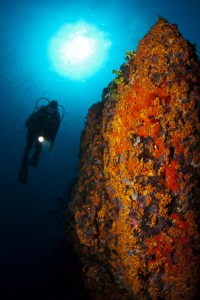
 All in all I had a great week at Cala Joncols. Next time I probably won’t go on my own as it’s quite a remote location. The resort is ideal for families, groups and clubs. All the facilities including food and accommodation are provided for on site, the boat is big and spacious and there is easy access to shore diving. To be perfectly honest everything ran very smoothly without any hiccups from the first moment I arrived at Girona until I returned back home a week later. In my mind this is the sign of a professionally run outfit that actually knows what they are doing and how to treat their clientele. The dive sites had fish life but don’t expect Turtles and Sharks. There were plenty of different coloured anemones and gorgonians and definitely no shortage of Moral Eels. I saw big Groupers on every site but they were easily spooked. Macro life was just about everywhere. Quoting the words of Mr Basil Fawlty himself, “A satisfied customer – we should have him stuffed!”
All in all I had a great week at Cala Joncols. Next time I probably won’t go on my own as it’s quite a remote location. The resort is ideal for families, groups and clubs. All the facilities including food and accommodation are provided for on site, the boat is big and spacious and there is easy access to shore diving. To be perfectly honest everything ran very smoothly without any hiccups from the first moment I arrived at Girona until I returned back home a week later. In my mind this is the sign of a professionally run outfit that actually knows what they are doing and how to treat their clientele. The dive sites had fish life but don’t expect Turtles and Sharks. There were plenty of different coloured anemones and gorgonians and definitely no shortage of Moral Eels. I saw big Groupers on every site but they were easily spooked. Macro life was just about everywhere. Quoting the words of Mr Basil Fawlty himself, “A satisfied customer – we should have him stuffed!”
I had been extremely lucky with the weather. We had brilliant sunshine and calm seas every single day. This only changed on my last non-diving day when the predominant wind known as the Tramontana started to blow through. Jan said “the wind usually lasts for 3 days but we can always go diving no matter what the weather”. This was another plus point for Cala Joncols. Jan explained that the other dive centres situated along the coast could not operate in these conditions but at Cala Joncols there was always somewhere protected from the wind.
1 week full board including Wine costs around 298 Euro. 10 dive pack including cylinder and weights is around 199 Euro. On the last pre-flight non-diving day Jan offers a boat excursion to the nearby town of Cadaques for 15 Euro per person or a tour around the local vineyard including wine tasting for around 10 Euro per person.
Information
E-mail: spain@euro-divers.com
Website: www.euro-divers.com
Tel no: +32 474649026
Gear News
Introducing the TR-80, IR-50 and CS-30 Regulators from DYNAMICNORD

Whether you are a beginner or a professional diver – with the three new main regulators from DYNAMICNORD, everyone will find their favourite regulator. They all look super stylish.
Excellent performance with the TR-80
Quality and performance are the be-all and end-all for regulators. It is not for nothing that the TR stands for Tec Reg. The innovative design of the TR-80 guarantees absolute reliability – even in ice-cold waters.

Perfect breathing effort at 0.8 J/l / certified for diving in waters below 10 degrees / structural design made of solid brass for best cold protection / membrane-compensated design with dry seal of the first stage / reduced exhalation effort thanks to optimized exhalation membrane and bubble deflector / adjustable Venturi (dive/predive) and adjustment knob for individual inhalation comfort / innovative design of the front cover prevents free-flow in strong currents or when diving with scooters / design made of sandblasted brass, matt chrome finish / 2 HP and 4 LP outlets / mouthpiece made of high-quality, anti-allergic silicone for maximum comfort.


Amazing underwater adventures with the IR-50
The IR-50 is the top regulator for advanced and experienced divers. Natural breathing is the essence of this regulator.

Ideal breathing effort at 0.8 J/l /certified for diving in waters below 10 degrees / compensated membrane / adjustable venturi (dive/predive) and adjustment knob for individual inhalation comfort/ outlet valve and deflector for minimum exhalation effort and reduction of bubbles on the face / design made of sandblasted brass, matt chrome finish / 2 HP and 4 NP outlets / mouthpiece made of high-quality, anti-allergic silicone for maximum comfort.


The Workhorse – our CS-30
For diving centres and diving beginners – the workhorse stands for strong construction, reliability and robustness. Perfect for your training.

Optimal breathing effort at 0.8 J/l /recommended for diving in waters above 10 degrees / non-compensated piston / adjustable venturi (dive/predive) / outlet valve and deflector for minimum exhalation effort and reduction of bubbles on the face / design made of sandblasted brass, matt chrome finish / 1 HP and 3 NP outlets / mouthpiece made of high-quality, anti-allergic silicone for maximum comfort.


Octopus OP-30
The OP-30 is the ideal addition to all DYNAMICNORD regulators. It is identical in construction to the CS-30.

The TR-80, IR-50, CS-30 (DIN & INT) regulators and the Octopus OP-30 are available from DYNAMICNORD dealers and in the online store.
DYNAMICNORD – Your Outdoor Companion.
Marine Life & Conservation
Paul Watson Released as Denmark Blocks Japan’s Extradition Bid

Renowned anti-whaling activist Paul Watson has been released from custody in Greenland after spending five months in detention. Denmark’s Justice Ministry rejected Japan’s request for his extradition, citing insufficient guarantees that his time already served in custody would be credited against any potential sentence.
The 74-year-old Canadian-American was arrested on July 21 in Nuuk, Greenland’s capital, when his ship docked to refuel. His arrest was based on a 2012 Japanese warrant related to a 2010 encounter in Antarctic waters. Japan alleged Watson obstructed operations and caused damage to a whaling research ship during efforts to disrupt illegal whaling. Watson has consistently denied these claims, maintaining his commitment to marine conservation.
Denmark, which oversees extradition matters for Greenland, concluded that while the legal conditions for extradition were met, the lack of assurances from Japan regarding time-served credit made extradition untenable.
In a video shared by his foundation, Watson expressed gratitude and relief, saying, “After five months, it’s good to be out… and good to know they’re not sending me to Japan.” He added that the most difficult part of his time in custody was being separated from his two young sons.
Watson is a pioneering figure in marine conservation, known for founding the Captain Paul Watson Foundation in 2022 after decades of activism with the Sea Shepherd Conservation Society. His bold efforts to defend marine life have earned him widespread support, including from celebrities and conservationists. His work has also been featured in the acclaimed reality TV series Whale Wars.
Watson’s lawyer, Jonas Christoffersen, praised the decision, stating, “We are happy and relieved that Paul Watson is now free.” He added that Watson is eager to reunite with his family and continue his vital work.
The arrest occurred while Watson’s vessel, the M/Y John Paul DeJoria, was en route to the North Pacific with a team of 26 volunteers to intercept a Japanese whaling ship. His foundation described the arrest as politically motivated and emphasized that Watson’s actions were focused on ending illegal whaling practices.
Japan resumed commercial whaling in 2019 after leaving the International Whaling Commission, asserting that whale meat is a cultural tradition. Conservationists, however, continue to challenge these practices, highlighting their impact on marine ecosystems.
Despite the challenges, Watson remains steadfast in his mission to protect marine life and bring attention to whaling practices. His dedication to ocean conservation has made him a globally respected advocate for the environment.
-

 News2 months ago
News2 months agoIconic SS United States to become the World’s Largest Artificial Reef
-

 News3 months ago
News3 months agoBook Review – 52 Assignments: Underwater Photography
-

 Gear News3 months ago
Gear News3 months agoDYNAMICNORD – New German diving brand enters the British market
-

 News3 months ago
News3 months agoExploring Cenote El Pit: A Diver’s Dream
-

 Gear News3 months ago
Gear News3 months agoTry BARE drysuits (and maybe even win one!) this Friday with Sea & Sea at North West Dive Fest
-

 Marine Life & Conservation3 months ago
Marine Life & Conservation3 months agoBook Review: Coral Triangle Cameos
-

 Blogs2 months ago
Blogs2 months agoDive the Egyptian Red Sea this Autumn with Regaldive
-

 News3 months ago
News3 months ago2024 Ocean Art Underwater Photo Competition Announced



